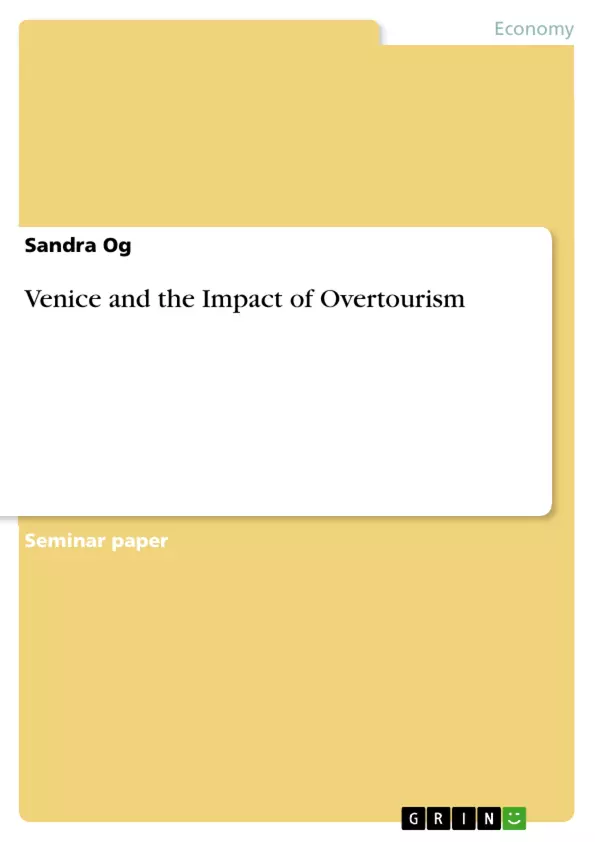It is Easter Sunday 2018 and there are 125,000 visitors in Venice, a number that the country of Bangladesh welcomes annually.
The increasing in cheap airfare has triggered a boom in the tourism industry. 2017 saw 1,3 billion international travelers, a growth of 7% over 2016. There are more people travelling around the world than ever before. Moreover, the way of traveling has changed from a few-day trips, including overnight stays in hotels and exploring the city and getting to know the locals, to day- or hour-long trips.
In the 17th century a trip to Venice was affordable by only the upper class of northern Euro-peans, who visited the city as a part of their Italian tour. Writers and artists were inspired by the magic of the lagoon city. The most romantic of cities, that is what visitors considered Venice and it has that reputation still to this day. Tourism is the main economy of Venice and it offers a lot of job opportunities. But on the other hand, it is one of the most touristic cities in the world with 30 million visitors annually, and that for a city with a population of 55,000. Tourists overflow the city, they are not concerned in supporting sustainability of the city and not conscious about the negative impact they leave behind. One could argue that tourism has become an issue rather than a resource for Venice. The natural environment of Venice and its residents are suffering from their popularity and the effects of overtourism. I would argue that all stakeholders in the tourism sector in Venice need to urgently act and start building a sustain-able future for the city. To withstand overtourism and to save the city and its inhabitants from extinction.
This essay outlines positive and negative impact of overtourism in Venice concerning the economy, the social sector and its natural environment. Additionally, it will provide a short illustration of Venice’s history and the meaning of overtourism as well as solutions that Venice could implement and new suggestions to save Venice from overtourism.
Table of Contents
- Introduction
- Overtourism
- Overtourism
- Venice
- Overtourism in Venice
- Implications of Overtourism in Venice
- Positive Impact
- Negative Impact
- Solutions
- Conclusion
Objectives and Key Themes
This essay investigates the impact of overtourism in Venice, analyzing both the positive and negative effects on the city's economy, social sector, and natural environment. The paper aims to demonstrate how overtourism has become a complex issue for Venice, highlighting the need for sustainable solutions to protect the city's future.
- The economic benefits and challenges of tourism in Venice.
- The social impact of overtourism on the lives of residents.
- The environmental consequences of excessive tourism in Venice.
- The need for sustainable tourism practices to mitigate the negative effects of overtourism.
- Potential solutions to manage tourism and protect the city's cultural heritage and environment.
Chapter Summaries
The introduction presents the context of overtourism in Venice, highlighting the dramatic increase in tourist numbers and the shift from traditional travel to shorter, more frequent visits. The chapter emphasizes the importance of the tourism industry to Venice's economy while acknowledging the negative consequences of overcrowding. The essay argues for the urgent need to address overtourism and create a sustainable future for the city.
The chapter "Overtourism" defines the concept of overtourism and its impact on destinations worldwide. It then focuses on the specific case of Venice, discussing the city's history and the role of tourism in its development. The chapter examines how overtourism has affected Venice, highlighting the challenges faced by residents and the impact on the city's cultural and natural environment.
The chapter "Implications of Overtourism in Venice" explores the positive and negative impacts of overtourism on the city. It analyzes the economic benefits of tourism, including job creation and revenue generation, but also examines the negative economic consequences of overcrowding, such as increased prices and a decline in quality of life. The chapter further examines the social and environmental consequences of overtourism, highlighting the strain on infrastructure and the potential damage to the city's unique heritage.
Keywords
This essay focuses on the key concepts of overtourism, sustainable tourism, economic impact, social impact, environmental impact, Venice, and cultural heritage. The paper aims to provide a comprehensive analysis of the complex challenges posed by overtourism in Venice, highlighting the need for sustainable solutions to protect the city's future.
- Arbeit zitieren
- Sandra Og (Autor:in), 2018, Venice and the Impact of Overtourism, München, GRIN Verlag, https://www.grin.com/document/598490



